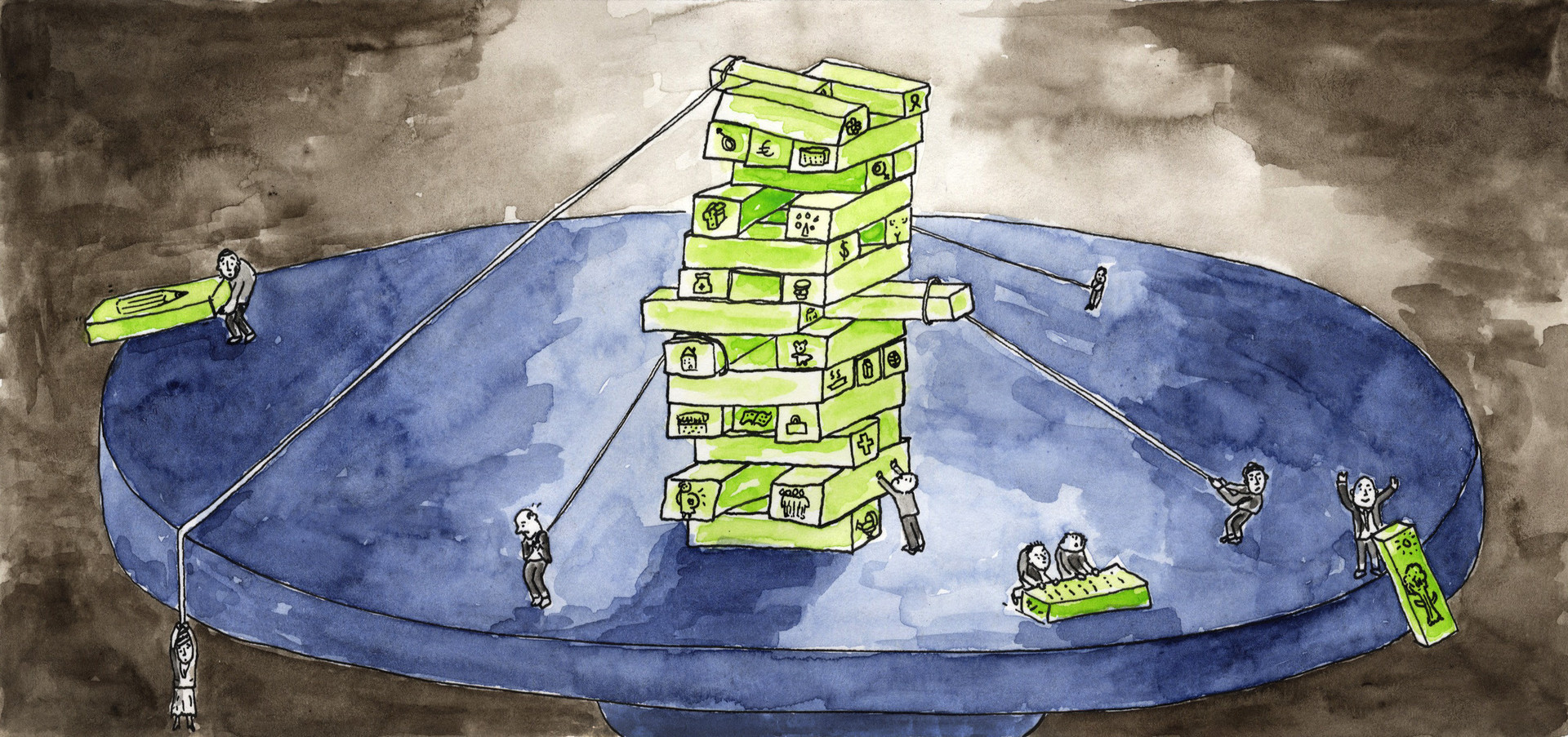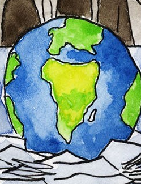They’re holed up in the basement. Two men, one from Iceland and one from Saudi Arabia. There are no windows, just a fluorescent lamp. They haven’t been outside for two days, because they have to come to an agreement. About whether women around the world should or should not have the right to make their own choices about sex and reproduction in 2030.
It’s the middle of the night. The men are red-faced. One slams his fist on the table, the other jumps up. His chair clatters onto the floor.
When you think of deliberations at the United Nations, you think of gray suits. Bone-dry prose rattled off in those little microphones that stick out of the tables like antennae.
When you think of deliberations at the United Nations, you think of bone-dry diplomatic prose. What you don’t think of is a fistfight in the basement.
What you don’t think of is a fistfight in the basement. A society with the mysterious name “the secret friends.” Or the adjective “messy,” if it concerns a meeting.
Yet these were the terms that we heard while doing our research on the negotiations for the United Nations’ new Sustainable Development Goals.
Using about forty interviews with negotiators and other involved parties we reconstructed the game that’s played when the whole world tries to cut a deal together. And that teaches us everything we need to know about the failure – or success – of international cooperation.
The game could be compared to playing Jenga. You remember, one of those wobbly towers made out of wooden blocks, where you have to keep removing a block to build the tower higher? The tower gets increasingly unstable with each move. Here, too, the question is: will this negotiating tower stay upright?
What’s at stake?
But first: what were the negotiations about? First, they were about the U.N.’s so-called Sustainable Development Goals. A list of goals for a better world, which should be achieved by 2030. It’s important, because a list like this determines what people are going to spend their aid budgets on in the coming fifteen years.
But it’s not just cash flows at stake during the negotiations, which have been going on for four years now – but also the future of international cooperation. Indeed, the U.N. has been under pressure for some time now. One climate change summit after the other is failing, as are attempts to agree on fairer rules for international trade. The war in Syria continues to escalate as well. If these negotiations fail, it would not only cause the foundations of the United Nations to cave in – the aspiration to work towards a better world together – but it would also extinguish the last ray of hope that the world can tackle problems together.
Now we join the negotiating table, where the game is really played. Sitting at the table are the member states of the United Nations.
The opening move: the secret friends
Paula Caballero is a person on a mission. “It’s as if she’s been hit by a thunderbolt,” is how one of her colleagues describes her. She has bright blue eyes and speaks in the rhythm of an AK-47.
It’s May 27, 2011. Caballero is making a presentation to the Colombian delegation at the U.N. in New York. We’re destroying the world, Caballero says. And we need a rescue plan. A better rescue plan than we have now. Because, says Caballero, ‘right now we’re focusing on eradicating poverty, but we also have to find a way to prevent the poverty of tomorrow.” How? By putting together a list of development goals that are not just about development but also about sustainability. She calls them – with typical U.N. originality – the Sustainable Development Goals. Or in U.N. vernacular, the SDGs.
Illustration by Tjarko van der Pol

The Colombian diplomats look at her, ask a few questions, yawn. You can hear them thinking: Who is this woman, and why is she speaking so quickly? But the Colombian president, for whom Caballero works at the ministry of foreign affairs, is enthusiastic about the idea. Paula, he says, go ahead and take care of it.
And so Caballero begins to make the rounds through the corridors and back rooms of the U.N. There are lunches and dinners, she makes phone calls, chats with people. And then, after a few months, at a conference in Rio de Janeiro after her umpteenth presentation, she finally starts to feel some momentum gathering. Guatemala joins here. Cuba and Norway seem enthusiastic.
Another few months pass by and Caballero has managed to get a group of about ten diplomats on her side who also express interest in the Sustainable Development Goals. Partners in crime, as she describes them. Colleagues jokingly call them “the secret friends of the SDGs.” Secret, because the diplomats working with her are not always doing so in the name of their country. That’s certainly the case with the Pakistani diplomat – now referred to in the U.N. as the “father of the SDGs” – who is much more progressive in his thinking than his government.
The secret friends’ idea is to settle on the themes of the new goals during the Rio+20 conference in Rio de Janeiro in June 2012. But they are slightly overoptimistic.
Indeed, the secret friends meet with resistance from the very first opening move. Several diplomats tell them that Brazil, for example, is “thwarting everything there is to thwart." Indeed, this country – like many other emerging economies – wants to make sure that development continues to mean economic growth. Worrying about sustainability will impede growth.
No list emerges from the week in Rio. But another document does: The Future We Want. It’s a woolly summary of 283 points and resolutions, in which the word “sustainable” appears as many as 390 times. There are no deadlines. But they do decide to continue the discussion in a working group.
One of the secret friends admits that this is “a huge disappointment” for them. “If you really find something unimportant at the U.N., you either do a study or put together a working group. Everyone clearly thought, let that working group fiddle around for a year. The goals will die an invisible death.”
Caballero’s opening move seems to be the last move of the game.
Who’s playing?
But then something happens that no one expects. There’s a run for the thirty seats in the working group. Suddenly everyone wants to join the conversation about what the new goals should look like. The secret friends are dumbfounded.
The Netherlands comes up with the idea of having several countries share a seat. Each seat can only represent one target, so the partners sharing a seat – referred to as troikas – have to come to an agreement. This system is new in the U.N., and it takes about nine months to form the troikas. “Not one bloody thing happened in these nine months,” says one of those involved. “They basically bickered about how it should all be done.”
Illustration by Tjarko van der Pol
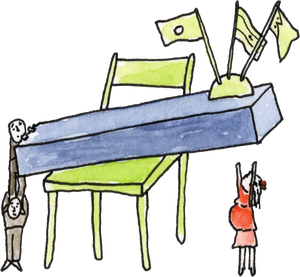
The Netherlands ends up sharing a seat with Australia and Great Britain. That means “quite a bit of scrimmaging,” says a Dutch diplomat. Especially when it comes to the environment. The Australians are adamant about a goal that protects the oceans, but the Brits feel it has little to do with development.
This is peanuts compared to some of the other troikas though. Japan, Nepal, and Iran are relegated to a common seat because no one wants to work with them. But there’s little common ground between their views.
After nine months, 30 seats are occupied by 70 countries. And as U.N. history shows, there’s no way that many countries will reach an agreement about something so monumental.
The blocks are put on the table
But there’s something special going on in this game: these troikas break up regional blocks such as the European Union and the G77. And that’s something that gives the negotiators much relief. The G77, for example, consists of oil states, but also small island nations that promote sustainable energy. “Small islands were suddenly given a much stronger voice,” says one of the negotiators.
At the same time, the smaller, poorer countries don’t have the capacity to keep up with the game. They have tiny U.N. missions (“Which most people consider irrelevant,” a diplomat told us), but countless issues that they have to deal with. “These countries are completely overshadowed by the Brazilians, for example, who have a delegation of fifty people in New York,” says a Dutch insider.
Enter the co-chairs of the working group – the game masters, as it were. A Hungarian and a Kenyan. In the working group’s initial months, which begin in July 2013, the chairs decide that all countries have be sufficiently informed about the issues before moving forward. They set up what is basically a crash course in sustainable development with more than a hundred leading experts from all over the world.
In doing so, they essentially put the blocks that build the Jenga tower onto the table. Only now will they begin to discuss the details of the goals. “We wanted the countries to give us an impression of what a better future would look like,” says Csaba Kőrösi, the Hungarian co-chair. “What they brought to the table had to be positive. And fully backed by fact.”
The tower is built
Illustration by Tjarko van der Pol

“Negotiations are usually a zero-sum game,” says co-chair Kőrösi. “What you gain is my loss.” To prevent all negotiators from becoming immediately entrenched, the chairs decide to avoid using the word “negotiation.”
Instead, they propose a different kind of negotiation – our game of Jenga. The favorite blocks of various countries can stay on the table, providing they are in the right balance. A British diplomat summarizes it as follows: “Nothing is certain until everything is certain.”
That’s how the chairs gradually win over the negotiators. Almost all of the negotiators that we speak to praise the two chairs. “Time and again they had to listen to the same statements,” recalls one of the negotiators. “At least I could walk out every now and then and get a cup of coffee, but they had to give everyone the same amount of attention.”
We ask Kőrösi how the partnership between the Hungarian and the Kenyan went. “Next question,” says Kőrösi immediately. He laughs when we don’t ask a new question. “Because we didn’t want countries to fight with each other, we had to do the fighting. But we were mentally prepared for it.”
The first blocks fall
Once the tower has been erected, the game can really start. There are several issues that barely need discussing: poverty, education and health.
But as soon as countries encounter blocks with a little more resistance, negotiations stall again. That’s partly because of the way the game is set up: the working group meets in a room that resembles a semi-circular Greek theater. The negotiators face the co-chairs and look onto the backs of the heads of their co-negotiators – which is not a convenient set up when you’re trying to reach a mutual agreement.
Illustration by Tjarko van der Pol

Moreover, representatives of NGOs, action groups and businesses are sitting at the back of the forum, because the working group is a public affair. So countries are not willing to openly commit themselves.
The secret friends find that it’s all going too slowly. They need to find a place where negotiators can talk face to face, without the piercing gaze of the outside world – literally – on their backs. “Diplomats are the most risk averse civil servants you’ll ever meet,” says an insider. “Success means keeping the boss happy. The substance is less important.”
So that negotiators can start talking about the substance, the secret friends start to send invitations for weekend retreats in the rurally situated Tarrytown, a 45-minute drive from New York. They rent an enormous country house – “the maze of Tarrytown” – where everyone can stay over.
The secret friends prepare an assignment to get the negotiators to start thinking about the various issues. “When I saw China, India and Egypt crawling around on the floor with colored balls of yarn to connect issues such as water, women’s rights and education with each other, I thought, perhaps it is going to work out after all,” says Kitty van der Heijden, one of the organizers of the Tarrytown Retreats, as the meetings came to be known. “We could now discuss things that we disagreed about.”
The game is finally in full swing.
The tower teeters
But there always comes a point in a game of Jenga when the easy blocks are knocked out of the tower. After that, there are only difficult blocks left, blocks that make the tower teeter. It is clear in Tarrytown which blocks these are.
First, the women’s rights block. “The world is split about sexual and reproductive rights for women,” says a Dutch diplomat. It happens as soon as the chairs present new goals at seven in the morning: countries like Saudi Arabia and Iran immediately go to the co-chairs to tell them “you have to tone it down on the women’s rights.”
But perhaps the most controversial blocks are about “peaceful societies” and “the rule of law.”
Proponents (mostly Western and low-income countries) believe that development is impossible without peace and a stable rule of law. Detractors (mostly emerging economies), meanwhile, are saying: keep your paws off our sovereignty. Even if the U.N. has something to say about it, it needs to go through the Security Council.
Another difficult block: climate change. There are two schools here too. The first, which contains many island nations, for example, believes that if we don’t take action against climate change, then all the other development goals are pointless too. Then all the new houses that we build will be flooded sooner or later, or all of our fields will dry up. That’s why we have to tackle climate change and development simultaneously, and not develop at the expense of the climate.
Illustration by Tjarko van der Pol
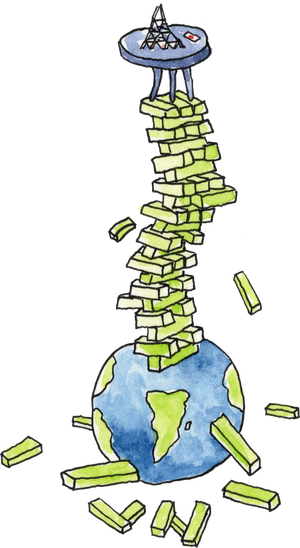
The other school, which includes Great Britain, for example, argues that we need to see climate change and development as isolated entities. There are separate U.N. negotiations going on about climate change, and they’re not making much headway. It’s hard enough to put together a short list, so why not scrap climate change altogether?
The second school receives support from major emerging economies, such as India, Brazil and China. They have a different argument why to exclude climate change from the list: the west bears most responsibility for climate change, so let them solve it. Now it’s finally our turn to grow, and you want us to worry about the climate?
One diplomat confides the following to us: “To you, these negotiations seem to be about sustainable development. But that’s not the case. For some it’s about who’s going to be ruling the world in 2030. And the likely candidates want as few new rules as possible that will prevent them from taking power.”
The tower teeters.
The last blocks
As always with Jenga, you only know at the very last minute whether the tower will stay upright. That’s when you know who the best negotiator is.
That’s partly related to perseverance. When negotiators describe the last days of the negotiation process, they always speak of bags under their eyes and “permanent jetlag.” They start early in the morning and go on till 1:00 or 2:00 a.m. “You’re incredibly tired, but you still have to be eloquent enough to negotiate,” one negotiator tells us.
On the last night, the Netherlands, East Timor, Liberia, and Sierra Leone sit across from Brazil and China. What’s on the table now is a compromise: not two separate blocks about peaceful societies and the rule of law, but one block in which the rule of law becomes a sub-goal of peaceful societies. In the end, Brazil and China agree to allow this block into the tower. One of the negotiators tell us, “I leaned forward and whispered into the Brazilian’s ear: are you really going to go to all these NGO colleagues later in the forum and say that the democracy Brazil is against peaceful societies? That would be a PR disaster.”
On the last night, the Netherlands, East Timor, Liberia, and Sierra Leone sit across from Brazil and China. What’s on the table now is a compromise.
In the meantime, a powerful coalition of countries has emerged against the climate change block. The co-chairs have already come up with three proposals, but they are all rejected by a majority. It’s the last public sitting of the work group. Once again it seems as if the countries won’t reach an agreement. Then co-chair Csaba Kőrösi takes the floor. He talks about his sixteen year-old daughter Lili. “When I told her that many countries didn’t want the climate change goal, she didn’t mince words: ‘Dad, you’re crazy. Tell those people they don’t have the right to put my future at risk. If there’s no climate change goal, you might as well not have any goals at all.’”
It’s momentarily quiet in the forum.
Then people start to applaud. That same evening there’s a climate change goal.
The game is played all night long. But the next day, around lunchtime, the co-chairs close their files. “Done!” they cry out. All of the diplomats look like they’ve been run over. But they’re cheering. They’ve done it: the tower has stayed standing. And it contains seventeen blocks.
What good is a tower that teeters?
But the tower’s a mess. It’s high, and it teeters and totters. Touching any of the blocks is essentially impossible at this point: it would almost certainly collapse.
There are two views about the outcome of the game – on the point of having seventeen development goals.
The first views says that sustainable development is simply a complicated issue. This is the best outcome that we can expect from so many countries. “Of course, I can put together a better list of goals in five minutes,” several diplomats tell us. “But with this many countries, this was the only possible outcome.”
The second views says that’s all fine and well, but a long list of goals like that is pointless. You’ll never achieve them all in fifteen years (and so the difficult goals will remain), it costs too much, and nobody can remember them all. “The previous goals fit on a refrigerator magnet,” says an insider, “but the Sustainable Development Goals will take up your whole fridge.”
But every attempt to shorten the list of goals meets with fierce opposition. Everyone’s afraid that everything will collapse like a house of cards if a single block is touched. “A good outcome in the U.N., is an outcome everyone is dissatisfied with,” is how one diplomat summarizes it for us.
Even if the tower isn’t touched, it’s still not certain that it will survive. Indeed, there are at least three occasions this year when it could collapse. The first is next month, during a summit in Addis Ababa, where it will be clear whether enough funds will be pledged to implement the goals. Then in September, when people can still vote against the goals at the General Assembly in New York. And again in December, during the climate change conference in Paris: a bad outcome at that conference would essentially make it impossible to achieve the sustainable development goals. One negotiator even goes as far as to say: “If one of these three conferences fails, then all three will fail, and our entire multilateral system will come crashing down.”
But what if the tower does manage to stay standing? Then perhaps it’s not such much the substance of the goals that’s a victory for the United Nations but the way that they came into being. Everyone agrees that these negotiations are unique. They’ve been open to input from all strata of the world population; they’ve given small countries the opportunity to negotiate outside their regional blocks; and they’ve excluded U.N. agencies that are only out to get attention for their own issues.
“The U.N. has been doing a lot of soul searching these past three years,” says a diplomat. And perhaps this Jenga tower is an example of how the U.N. should work in the future. Who knows, perhaps the climate change negotiators – who are going to regroup in December – can learn by example.
—Translated from Dutch by Mark Speer
More from The Correspondent:
 Poverty 101: How can we end global poverty once and for all?
By 2030 the world must be free of extreme poverty. The question is how? Of course there’s no single answer. In this crash course on global poverty, we bring together as many answers as we can. We’ll look at the extent of the problem, the causes, and possible solutions.
Poverty 101: How can we end global poverty once and for all?
By 2030 the world must be free of extreme poverty. The question is how? Of course there’s no single answer. In this crash course on global poverty, we bring together as many answers as we can. We’ll look at the extent of the problem, the causes, and possible solutions.
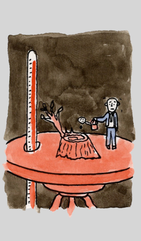
 Climate Change 101: Our future on a warming planet
Right now, it looks as if life on earth is going to get a lot more uncomfortable, thanks to the effects of global warming. But it’s precisely in periods of great change that our decisions, our actions – and the stories we tell one another – make the biggest difference. In this crash course, we explore why global warming is dangerous and what’s being done to put a stop to it.
Climate Change 101: Our future on a warming planet
Right now, it looks as if life on earth is going to get a lot more uncomfortable, thanks to the effects of global warming. But it’s precisely in periods of great change that our decisions, our actions – and the stories we tell one another – make the biggest difference. In this crash course, we explore why global warming is dangerous and what’s being done to put a stop to it.
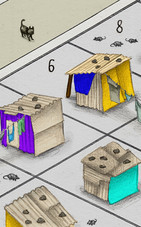 What’s deadly dull and can save the world? (Hint: We can’t stand it)
What do poor people need most? Food? Healthcare? Education? The answer is as surprising as it is simple. And it can be found under fluorescent lights and modular ceilings.
What’s deadly dull and can save the world? (Hint: We can’t stand it)
What do poor people need most? Food? Healthcare? Education? The answer is as surprising as it is simple. And it can be found under fluorescent lights and modular ceilings.
 The world’s not changing faster than ever at all
The world is changing faster than ever. And we’re going to have to adapt faster than ever too, just to keep up. At least that’s the cliché. But a new book gives short shrift to that notion. We’re not living in a period of technological revolution after all, author Robert J. Gordon argues, but in a period of technological stagnation.
The world’s not changing faster than ever at all
The world is changing faster than ever. And we’re going to have to adapt faster than ever too, just to keep up. At least that’s the cliché. But a new book gives short shrift to that notion. We’re not living in a period of technological revolution after all, author Robert J. Gordon argues, but in a period of technological stagnation.



